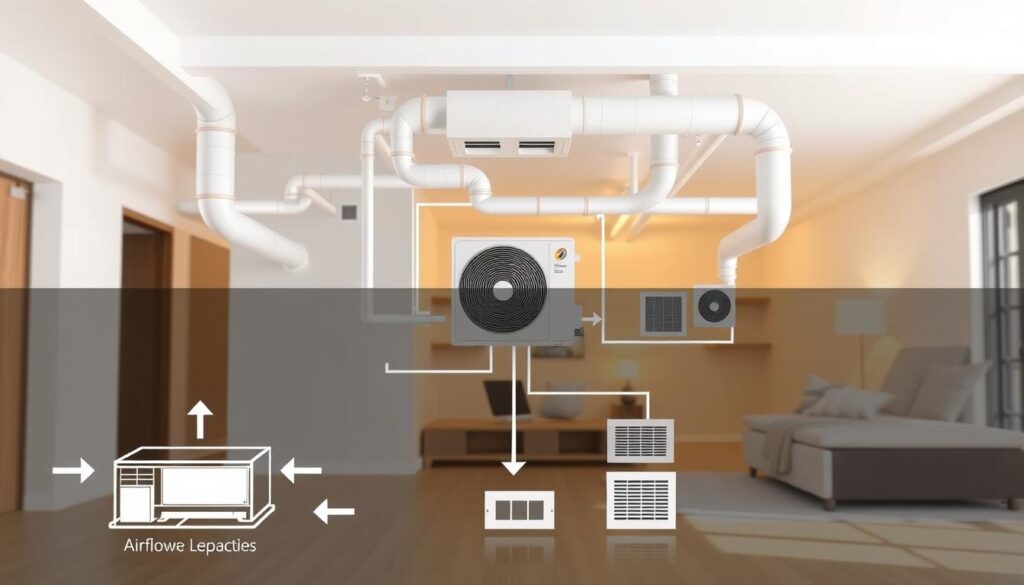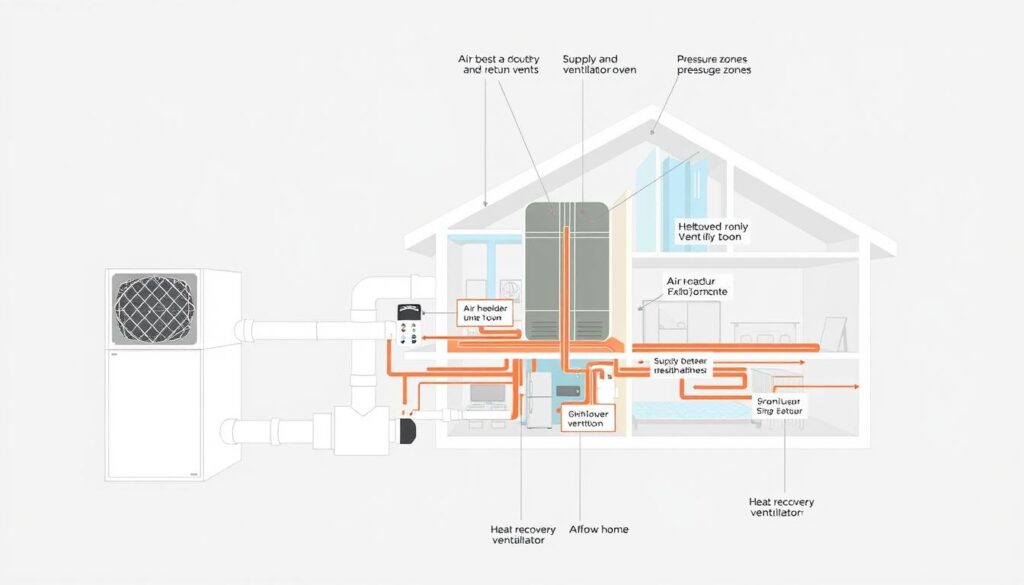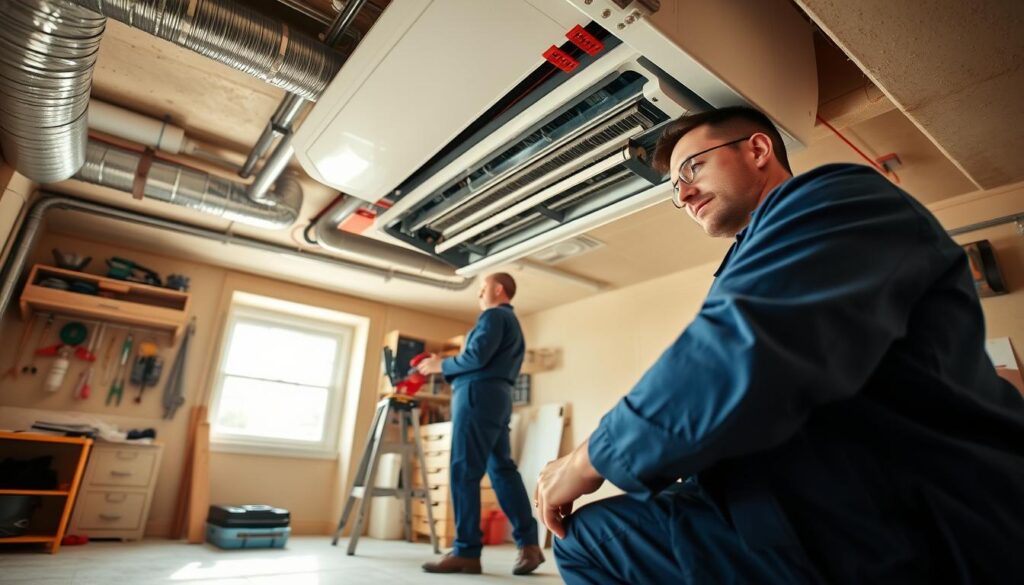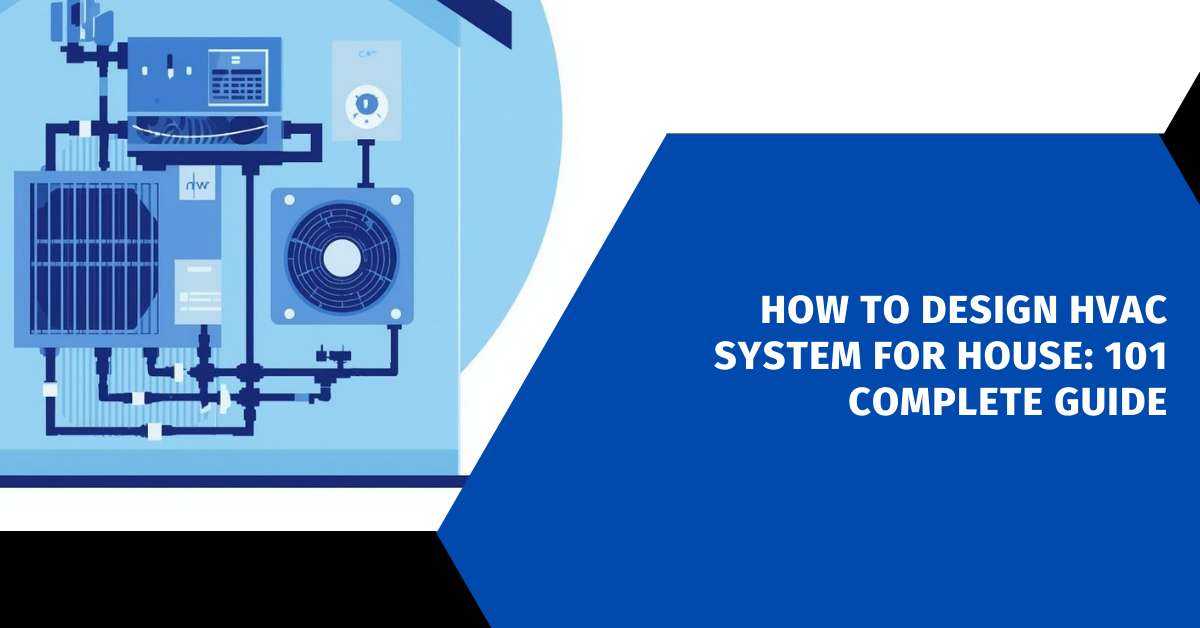Affiliate Disclosure
HVAC Guide Guys is a participant in the Amazon Services LLC Associates Program, an affiliate advertising program designed to provide a means for sites to earn advertising fees by advertising and linking to Amazon.
How to Design HVAC System for House? Are you tired of uneven temperatures and sky-high energy bills? What if you could design the perfect residential HVAC system? This system would keep your home comfortable and save you money.

Designing an HVAC system for your house is more than just buying equipment. It needs careful planning, technical skills, and knowing your home’s heating and cooling needs.
This guide will show you how to design your home’s HVAC system. You’ll learn how to make your home comfortable and energy-efficient. Whether you’re building a new home or upgrading, you’ll get the key insights to create the best HVAC solution.
Key Takeaways
- Understand the fundamentals of residential HVAC design
- Learn how to calculate precise heating and cooling loads
- Discover strategies for energy-efficient system selection
- Identify key factors in equipment placement and sizing
- Recognize the importance of professional consultation
Table of Contents
Understanding HVAC System Fundamentals
To design a great home heating and cooling system, you need to know how HVAC systems work. Your home’s comfort depends on understanding these complex systems. They keep your indoor environment perfect.
Energy efficient hvac systems have key components that work together. They regulate temperature and air quality. Let’s look at the essential parts that make these systems work well.
Key Components of Modern HVAC Systems
- Compressor: The heart of the cooling system
- Evaporator coils: Responsible for heat absorption
- Condenser unit: Releases collected heat outside
- Blower motor: Circulates air throughout your home
- Ductwork: Channels air to different rooms
Basic Operation Principles
HVAC systems work by transferring heat. In summer, they take heat from indoor air and move it outside. In winter, they bring warmth inside.
Types of HVAC Systems
Homeowners have many HVAC system options:
- Split Systems: Traditional setup with indoor and outdoor units
- Ductless Mini-Splits: Flexible solution for targeted heating and cooling
- Hybrid Systems: Combine electric and gas heating for efficiency
- Geothermal Systems: Use ground temperature for extreme energy savings
Choosing the right HVAC system can significantly reduce your energy consumption and improve home comfort.
Knowing these basics helps you make smart choices for your home’s heating and cooling. It ensures your system works well and saves energy.
Explore Our HVAC Shop
Looking for top-rated HVAC tools, parts, and accessories? Visit our shop and find the perfect solution for your needs.
Visit the ShopLoad Calculation and System Sizing
Getting the right HVAC size for your home is key for comfort and saving energy. Choosing the wrong size can cause big problems. It can affect your comfort, energy use, and how well your system works over time.
The manual j load calculation is the best way to figure out what your home needs. It looks at many important things:
- Home square footage
- Insulation quality
- Window types and placement
- Local climate conditions
- Number of occupants
- Heat-generating appliances
Getting the load calculation right helps avoid common mistakes. A system that’s too big will waste energy and not keep temperatures even. A system that’s too small won’t keep your home cool or warm enough, leading to higher bills.
“Precision in HVAC sizing is not a luxury—it’s a necessity for home comfort and energy efficiency.” – HVAC Engineering Professionals
Experts use special software for manual j load calculations. This makes sure your system fits your home perfectly. By doing this, you’ll save on energy, stay comfortable, and make your system last longer.
How to Design HVAC System for House
Creating the ideal HVAC system for your home needs careful planning. It’s important to know how each area of your home has its own heating and cooling needs. A well-designed HVAC system can make your home more comfortable and energy-efficient.
- Assess each room’s specific requirements
- Understand zoning options for home hvac
- Select appropriate equipment
- Consider individual space characteristics
Determining Room-by-Room Requirements
Every room in your home has its own thermal needs. Things like sun exposure, room size, and how you use the room affect temperature control. Bedrooms might need cooler settings than living areas.
Think about rooms with big windows, high ceilings, or lots of sun when designing your HVAC system.
Zoning Considerations
Zoning options for home hvac let you control temperature in different areas. You can set up zones for different comfort levels. For example, keep your bedroom cool while your living areas are warmer.
- Reduce energy waste
- Personalize temperature settings
- Improve overall system efficiency
Equipment Selection Criteria
Choosing the right HVAC equipment is key. Look for systems that are energy-efficient, the right size for your home, and fit your home’s layout.
Professional tip: Always consult with a certified HVAC technician to ensure your system meets your home’s unique requirements.
Explore Our HVAC Shop
Looking for top-rated HVAC tools, parts, and accessories? Visit our shop and find the perfect solution for your needs.
Visit the ShopDuctwork Design and Layout Planning
Designing effective ductwork is key for your home’s comfort and energy use. A well-planned duct system ensures air flows well and saves energy.
When designing ductwork for your house, several important factors must be considered. The layout should fit your home’s unique design. This ensures good air flow and temperature control.
- Proper duct sizing prevents airflow restrictions
- Strategic routing maximizes system efficiency
- Insulation reduces energy waste
- Sealing prevents air leakage
Different duct materials have their own benefits for home HVAC systems. Homeowners can pick from:
| Duct Material | Pros | Cons |
|---|---|---|
| Flexible Ducts | Easy installation, low cost | More prone to damage |
| Sheet Metal Ducts | Durable, long-lasting | Higher installation costs |
| Fiberglass Ducts | Good sound insulation | Potential fiber shedding |
Professional consultation can help you choose the best ductwork design for your home.
Energy Efficiency Considerations
Creating energy efficient HVAC systems needs careful planning and new technologies. Your home’s comfort and energy use depend on smart design choices. These choices help your system work better while using less electricity.
Understanding energy efficiency is key. It affects your whole-house ventilation systems and home comfort.
SEER Ratings Explained
SEER (Seasonal Energy Efficiency Ratio) ratings show how well cooling systems work. Higher SEER ratings mean better energy use:
- Standard SEER ratings range from 13-21
- Modern high-efficiency systems reach 20+ SEER
- Minimum federal standards require 14 SEER for new installations
Insulation Requirements
Good insulation boosts HVAC system performance. Important insulation steps include:
- Seal air leaks around windows and doors
- Install high-quality attic and wall insulation
- Use weatherstripping to prevent heat transfer
Smart Technology Integration
Modern energy efficient HVAC systems use smart tech to work better:
| Smart Technology | Energy Savings |
|---|---|
| Programmable Thermostats | 10-15% reduction |
| Zoning Controls | 20-30% efficiency improvement |
| Smart Sensors | 8-12% energy savings |
Investing in energy-efficient technologies makes your whole-house ventilation systems smart and responsive.
Explore Our HVAC Shop
Looking for top-rated HVAC tools, parts, and accessories? Visit our shop and find the perfect solution for your needs.
Visit the ShopVentilation System Requirements

Creating effective whole-house ventilation systems is key for good indoor air quality. Your home’s ventilation plan affects your comfort, health, and energy use. It’s all about keeping your living space healthy and efficient.
Good ventilation gets rid of indoor pollutants, controls moisture, and brings in fresh air. Each area of your home has its own air quality needs. This means different ventilation solutions are needed for different spaces.
- Kitchen ventilation removes cooking odors and grease particles
- Bathroom exhaust prevents moisture buildup and possible mold growth
- Living spaces need consistent air exchange to reduce allergens and stale air
Residential HVAC design offers various ventilation system types. Each one is designed to meet your home’s specific needs:
| Ventilation Type | Key Characteristics | Best Used For |
|---|---|---|
| Exhaust-Only Systems | Removes indoor air through mechanical exhaust | Small homes with minimal air quality concerns |
| Supply-Only Systems | Introduces filtered outside air into living spaces | Homes in areas with good outdoor air quality |
| Balanced Ventilation Systems | Simultaneously exhausts indoor air and brings in fresh air | Comprehensive air quality management |
“Effective ventilation is not just about air movement, but about creating a healthy indoor environment.” – HVAC Design Experts
When designing your whole-house ventilation systems, think about your home’s size, local climate, and air quality issues. Working with a professional HVAC designer can help you create a customized ventilation plan. This plan will meet your home’s unique needs.
Equipment Selection and Placement
Choosing the right HVAC equipment for your home is important. You need to think about where it will go and what it needs. Your home’s layout and the weather around it help decide the best equipment.
Indoor Unit Location Strategies
When picking a spot for indoor units, keep these points in mind:
- Keep noise down in living areas
- Make sure it’s easy to get to for upkeep
- Help air flow well
- Stay away from sunlight and heat
Outdoor Unit Positioning Considerations
Outdoor units need the right spot for your heating and cooling system. Think about:
- Keeping it out of the sun
- Having enough air around it
- Installing it on level ground
- Reducing noise
Essential Clearance Requirements
Having the right space around your HVAC system is key. It helps it work well and last longer.
| Unit Type | Minimum Clearance | Recommended Space |
|---|---|---|
| Indoor Unit | 12 inches | 24 inches |
| Outdoor Unit | 24 inches | 36 inches |
| Surrounding Obstacles | 18 inches | 30 inches |
Professional tip: Always check the manufacturer’s guide for exact clearance needs for your specific HVAC model.
Cost Analysis and Budgeting
Planning your residential HVAC system needs careful thought about money. The cost of energy efficient hvac systems includes many factors. These factors affect your comfort and budget over time.
Understanding your HVAC project’s financial side is key. Your total costs will include:
- Equipment purchase costs
- Professional installation fees
- Potential system modifications
- Long-term energy consumption
When designing your residential hvac, think about these important money matters:
| Cost Category | Estimated Range | Key Considerations |
|---|---|---|
| Initial Equipment | $3,000 – $10,000 | Depends on system type and efficiency |
| Installation | $1,500 – $5,000 | Complexity of home layout |
| Annual Operating Cost | $500 – $2,000 | Energy efficiency ratings |
Your plan should weigh upfront costs against long-term savings. High-efficiency systems might cost more at first but can cut down on monthly bills.
Check for financial help like:
- Federal tax credits
- State energy rebates
- Manufacturer incentive programs
By looking at these money points, you can make a detailed budget. This budget should meet your comfort needs and budget limits.
Explore Our HVAC Shop
Looking for top-rated HVAC tools, parts, and accessories? Visit our shop and find the perfect solution for your needs.
Visit the ShopInstallation Guidelines and Best Practices
When designing a residential HVAC system, getting it installed by a pro is key. Your home’s comfort and energy use depend on it. The right HVAC design is essential.

Installing your HVAC system needs special skills. Trying to do it yourself can be risky and might not work right.
Professional Installation Requirements
Choosing the right HVAC pro is vital. They should have:
- NATE (North American Technician Excellence) certification
- State and local licenses
- At least 5 years of experience in residential HVAC design
- Good insurance
Safety Considerations
Residential HVAC design has many safety parts. Only pros should handle them:
- Checking electrical connections
- Handling refrigerant safely
- Setting up ventilation correctly
- Following local building codes
Professional installers know all about HVAC systems. They make sure your home is comfy and safe.
“A professionally installed HVAC system is an investment in your home’s comfort and efficiency.”
Always go for professional installation. It ensures your HVAC system works well, lasts long, and is safe.
Maintenance and Service Planning
Your home heating and cooling system planning doesn’t stop after installation. It needs ongoing maintenance for top performance and long life. Regular service keeps your system efficient and avoids expensive repairs.
Creating a detailed maintenance schedule is key for your HVAC system’s health. Regular care can make your system last longer and stay energy-efficient.
- Schedule professional annual tune-ups
- Replace air filters every 1-3 months
- Clean air vents and registers quarterly
- Check refrigerant levels annually
- Inspect electrical connections and components
Some tasks you can do yourself, while others need a pro. Knowing the difference saves time and prevents damage.
| Maintenance Task | Frequency | DIY or Professional |
|---|---|---|
| Air Filter Replacement | Every 1-3 months | DIY |
| System Tune-up | Annually | Professional |
| Refrigerant Check | Annually | Professional |
| Ductwork Inspection | Every 2-3 years | Professional |
Pro tip: Keep a maintenance log to track service dates and system performance. This helps identify issues early and keeps your warranty valid.
Regular maintenance protects your HVAC system, cuts energy costs, and keeps your home comfy. A well-kept system can last much longer than one that’s ignored.
Explore Our HVAC Shop
Looking for top-rated HVAC tools, parts, and accessories? Visit our shop and find the perfect solution for your needs.
Visit the ShopSystem Performance Optimization
To get the most out of your energy efficient hvac systems, you need a good plan and smart tech. Your home’s comfort and energy use depend on how well you manage your HVAC system.
Smart thermostats have changed how we control our hvac systems. These smart devices learn your temperature likes and adjust settings for you. They can cut energy use by up to 15% and give you real-time system efficiency info.
- Install learning thermostats with remote monitoring capabilities
- Create customized temperature schedules
- Use zoning systems to control individual room temperatures
- Monitor energy consumption through mobile apps
It’s important to check your HVAC system’s performance often. Get a pro to check it every year to keep it running well. They can:
- Check refrigerant levels
- Clean or replace air filters
- Inspect electrical connections
- Calibrate thermostat sensors
“Proactive maintenance is the key to long-lasting, energy-efficient HVAC performance.” – HVAC Industry Expert
By using these tips, you can keep your home comfy and save on energy. Plus, your HVAC system will last longer.
Conclusion
Designing an HVAC system for your house needs careful planning and smart choices. The process includes understanding the basics and choosing energy-saving options. Getting professional help is key to a successful design.
Important steps like calculating loads, picking the right equipment, and zoning are vital. They help create a comfortable home environment. Choosing the right parts and knowing how they work ensures your system works well for a long time.
A good HVAC design improves your home’s comfort, saves energy, and cuts down on maintenance costs. This guide offers a lot of useful information. But, every home is different.
Professional HVAC contractors can assess your home’s needs and suggest the best solutions. They also make sure everything is installed correctly. Taking the time to understand your home’s needs and getting expert advice is important.
Your HVAC system is a big investment. Keeping it in good shape with regular maintenance and updates is essential. This way, you can make the most of your system and adapt to changes in your home and environment.

